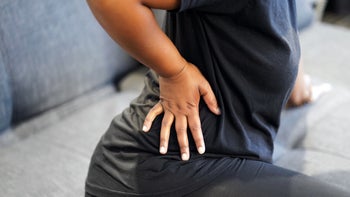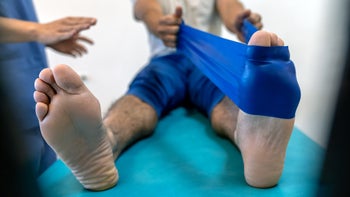
6 Strengthening Exercises for Flat Feet
Key takeaways:
People with flat feet have little to no arch. They may have a higher risk of ankle sprains, tendonitis, and plantar fasciitis.
Some people have a genetic predisposition to flat feet, while others develop it due to overuse, previous ankle injury, or inflammatory diseases.
Exercises for flat feet include foot- and hip-strengthening moves and stretches to promote normal foot alignment.
When you have flat feet, there is little to no arch in one or both feet. The sole of your foot may come into complete contact with the ground. Also called pes planus or fallen arches, flat feet is a fairly common condition affecting roughly 26% of the population. It can be hereditary, or it can develop over time.
In fact, most people have flat feet as children but will often develop arches by age 5 or 6. Others will develop them as they get older. Experts say the following can also cause flat feet:
Stretching and tearing of the posterior tendon (which supports your foot and holds up the arch) with overuse, causing arches to fall
Overweight or obesity
Pregnancy
Conditions including diabetes and rheumatoid arthritis
Advancing age
Search and compare options
You may notice a bump on the inside of your foot and have difficulty lifting your heel. Other symptoms of flat feet include foot and ankle pain and swelling. But some people might not have any discomfort. Flat feet can also stress your knees and hips, causing pain or injuries. The condition may put you at risk for ankle sprains, plantar fasciitis, bunions, and shin splints. Treatment might include exercises for flat feet that stretch and strengthen foot, calf, and ankle muscles.
What are the best exercises for flat feet?
Targeted exercises for flat feet help strengthen the muscles that support your arch. They have been shown to improve foot alignment and prevent the progression of flat feet. Hip- and ankle-strengthening moves can also help.
With your doctor's OK, you can perform the following exercises for flat feet at least three times per week.
1. Banded ankle adduction
The banded ankle adduction exercise strengthens the posterior tibialis muscle, which helps support the arch in your foot. Strengthening this muscle may improve the arch in people with flat feet. You'll need a resistance band for this exercise.
Step 1: Sit on the floor with your legs straight in front of you. Your back can rest against a wall or another sturdy surface.
Step 2: Loop a resistance band around the ball or sole of one foot.
Step 3: Hold the ends of the band with one hand.
Step 4: Pull the band until it is tight, keeping your heel stationary on the floor. Turn your foot in and then back to the starting position.
Step 5: Pull the band tighter if you don't feel resistance against the band as you move your foot in. Or use a tighter band for this exercise.
Step 6: Perform 2-3 sets of 15-30 repetitions on both feet.
2. Foot doming
Foot doming (also called arch lifts or "short foot") helps strengthen the intrinsic foot muscles. These small muscles help stabilize your feet and support your arches.
Step 1: Stand with your feet hip-width apart. Keep your feet relaxed.
Step 2: Keep your heels and toes on the floor and roll your weight to the outside while raising the arch of your foot. This will create a dome-like shape under your arch.
Step 3: Hold this position for 5 seconds and then relax to the starting position.
Step 4: Perform 3-5 sets of 20 reps on each foot.
3. Towel scrunch
The towel scrunch exercise is another strength-building move for small, intrinsic muscles.
Step 1: Sit in a chair and place a small towel under your feet.
Step 2: Keep your heels stationary and curl your toes to scrunch the towel, moving it closer to you.
Step 3: Scrunch the towel with your toes 15 times, ensuring that your heels do not move.
Step 4: Repeat for 2-3 sets.
4. Banded clamshell
The clamshell exercise strengthens the gluteus medius muscle in your hip. It might seem strange that hip exercises can help flat feet. But experts say that the gluteus medius directly affects foot alignment. A study found that a foot- and hip-strengthening exercise program was more effective than a foot-strengthening program for flat feet.
The banded clamshell takes the exercise to the next level by adding resistance.
Step 1: Lie on your side with your head resting on your hand. Put your other hand in front of you for support.
Step 2: Place a resistance band around your legs, just above your knees. Your legs should be bent and stacked on top of each other.
Step 3: Keep your heels together as you lift your top leg, separating your knees. You should feel the resistance from the band as you open your knees.
Step 4: Hold briefly before lowering your leg to the starting position.
Step 5: Do 2-3 sets of 15-30 reps on each side.
5. Heel and toe walking
Heel and toe walking works muscles that support your foot and ankle, including calf and foot arch muscles.
Step 1: Stand with your feet together. Lift the toes of both feet off the floor, resting your weight on your heels.
Step 2: Walk on your heels for 15 to 20 steps.
Step 3: Stand on your toes, lifting your heels off the ground.
Step 4: Walk on your toes for 15 to 20 steps. If you feel off-balance, hold a stable surface nearby for support.
Step 5: Repeat this sequence 3-5 times.
6. Standing calf stretch
The standing calf stretch lengthens the calf and promotes ankle and foot flexibility and range of motion.
Step 1: Stand about arm's distance away from a wall. Place your hands on the wall at shoulder level.
Step 2: Step one foot back. Your back leg should stay straight, with your foot flat on the floor. Bend your front leg slightly. (You will be in a lunge position.)
Step 3: Lean forward, keeping your back leg straight and your foot on the floor. You will feel a stretch along the back of your leg.
Step 4: Hold for 15 seconds.
Step 5: Repeat 3-5 times before switching to the other leg.
What are the best treatments for flat feet?
Children often outgrow having flat feet, and treatment is rarely required. Adults only require treatment if having flat feet causes them pain or injuries. Talk to your doctor about proper treatment if you are experiencing foot, ankle, knee, or hip pain with flat feet. A physical therapist can also be helpful if home exercises aren't working.
You should also get medical attention if you experience foot swelling or redness. In addition to exercise, the following treatments may also be helpful for those with flat feet.
Foot orthotics — such as a foot pad or shoe insert — are often recommended to support the arch and promote foot alignment. But according to a 2021 review, evidence on the effectiveness of orthotics for flat feet is lacking. Talk to your doctor to see if foot orthotics are right for you.
Shoes with a wide toe box allow your toes to spread. That may reduce pressure on your forefoot. Motion-control shoes — also known as high-stability shoes, designed to hold your foot firmly in place — may also be helpful.
A short dose of non-steroidal anti-inflammatories (NSAIDS) can help reduce pain and inflammation.
Rolling a tennis ball along the sole of your foot may help increase blood flow and reduce pain.
Surgery is rarely required unless you have a tendon tear or bone deformity.
What makes flat feet worse?
Let your pain be your guide. If you have pain during high-impact activities — such as running or jumping — you may need to modify your routine. That might mean temporarily switching to low-impact activities, such as swimming, biking, or using an elliptical. But if you don't have foot pain, you can continue your usual activities and exercises.
Avoid wearing high heels, flip flops, or shoes with a pointy or narrow toe for extended periods. These shoes provide little arch support and may increase pressure on your feet. Opt for supportive shoes with a wider toe box, especially when standing or walking for long periods.
The bottom line
People with flat feet or fallen arches may have foot, ankle, hip, or knee pain. Or they may have no symptoms at all. Talk to your doctor if you have pain or other symptoms.
Exercises for flat feet can help strengthen the muscles that support your arch to promote normal alignment. They may be included in a treatment plan that includes wearing supportive shoes or orthotics.
Why trust our experts?



References
Alam, F., et al. (2019). Effects of selective strengthening of tibialis posterior and stretching of iliopsoas on navicular drop, dynamic balance, and lower limb muscle activity in pronated feet: A randomized clinical trial. The Physician and Sportsmedicine.
Brijwasi, T., et al. (2023). A comprehensive exercise program improves foot alignment in people with flexible flat foot: A randomised trial. Journal of Physiotherapy.
Engkananuwat, P., et al. (2023). Gluteus medius muscle strengthening exercise effects on medial longitudinal arch height in individuals with flexible flatfoot: A randomized controlled trial. Journal of Exercise Rehabilitation.
ExRx.net. (n.d.). Wall straight leg calf stretch.
Fetters, A. [@kafetters]. Banded ankle adduction and abduction [video]. YouTube.
Herchenröder, M., et al. (2021). Evidence for foot orthoses for adults with flatfoot: A systematic review. Journal of Foot and Ankle Research.
Institute for Preventive Foot Health. (n.d.). Causes of flat feet.
Institute for Preventive Foot Health. (n.d.). Prevention and treatment of flat feet.
Mitchell, L. [@TheStrongAngle]. Towel scrunches exercise for flat feet plantar fasciitis and toe strength [video]. YouTube.
McIntyre, K. (n.d.). The benefits of foot doming exercise. Burlington Sports Therapy.
Openfit. How to do clamshells with resistance bands | Openfit [video]. YouTube.
Pita-Fernandez, S., et al. (2017). Flat foot in a random population and its impact on quality of life and functionality. Journal of Clinical & Diagnostic Research.
Raj, M. A., et al. (2023). Pes Planus. StatPearls.
Smith, C. J., et al. (2023). Progressive collapsing foot deformity (flatfoot). OrthoInfo.
Snyder, M. Heel and toe walk [video]. YouTube.

























